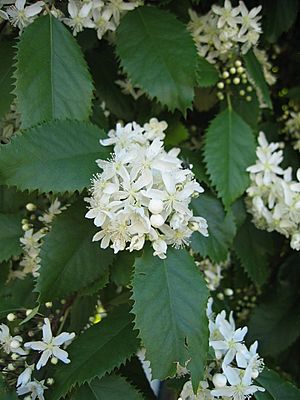New Zealand mallow facts for kids
Quick facts for kids New Zealand mallow |
|
|---|---|
 |
|
| Scientific classification | |
| Genus: |
Hoheria
|
| Species: |
populnea
|
The Hoheria populnea, also known as New Zealand mallow, lacebark, or houhere, is a beautiful flowering plant. It belongs to the Malvaceae family, which also includes cotton and hibiscus. This special tree is endemic to New Zealand, meaning it grows naturally only there.
Contents
Discovering the Lacebark Tree
The lacebark tree is a unique part of New Zealand's plant life. It's known for its pretty white flowers and interesting bark. This tree is not just nice to look at; it has also been very important to the Māori people for a long time.
Where Does the Lacebark Tree Grow?
You can find Hoheria populnea in New Zealand, from the coast all the way to lowland forests. Its natural home stretches from the North Cape at the top of the North Island down to the Bay of Plenty. It likes places where it can get enough sunlight and moisture.
What Does the Lacebark Tree Look Like?
The lacebark tree can grow quite tall, sometimes reaching up to 12 metres high. That's about as tall as a four-story building!
Leaves and Flowers
Its leaves are broad and oval-shaped. They are dark green and have jagged edges, like tiny saw teeth. Each leaf is usually about 5 to 12 centimetres long and up to 6 centimetres wide.
The tree produces lovely white flowers. These flowers grow in small groups and bloom from January to March. This is during the summer months in New Zealand.
How Māori Used Lacebark
For many years, the Māori people have used the lacebark tree in clever ways. They especially valued its bark.
Making Textiles and Crafts
The inner bark of the lacebark tree was very useful. Māori people carefully prepared it to make strong materials. They used these materials to create many different items. These included ropes, hats, baskets (called kits), and headbands. This shows how resourceful they were, using plants from their environment for everyday needs.
Early Experiments
There are old stories that tell of early attempts to make a felt-like material from the lacebark. This was similar to how aute, or paper mulberry, was used in other Polynesian islands. However, these attempts to make felt from lacebark were not successful. Even so, it shows how much the Māori people explored and understood the plants around them.

